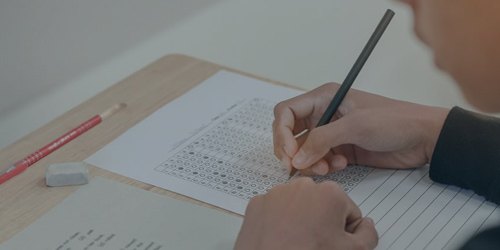NPAT 2021 Syllabus:
The syllabus for the NPAT 2021 will be published by the organizing authority on its official website along with the examination brochure. Students can download the syllabus with the brochure. The syllabus gives a brief idea of the important subjects that will be included in the questionnaire along with the important chapters and concepts. Those candidates appearing for the NPAT 2021 entrance exam are advised to go through the syllabus and the NPAT Exam Pattern set by the exam conducting authorities before starting their preparation for the exam so as to avoid any kind of confusion and hassle.
The syllabus of the entrance exam is mentioned below:
SYLLABUS – NPAT ENGINEERING
| Mathematics | Physics | Chemistry | Logical Intelligence | Proficiency in language |
|---|---|---|---|---|
| Sets and Functions | Physics and measurement | Physical Chemistry |
Critical Thinking |
Error Recognition |
| Matrices and Determinants | Kinematics | Some basic concepts in chemistry, States of matter | Decision Making (Take into cognizance various rules/ conditions and take decisions based upon those rules /conditions) | Recognising grammatical structure and usage |
| Permutation and Combination | Thermodynamics | Atomic structure | Problem Solving (To analyse the given information and condense all the information in a suitable form and answer the questions asked) | Applied Grammar |
| Mathematical Induction | Work, energy and power | Chemical bonding and molecular structure | Verbal-logical reasoning | Using prepositions |
| Binomial theorem and its Application | Rotational motion | Chemical thermodynamics | Derive conclusions from logical premises or assess the validity of arguments based on statement of facts | determiners |
| Sequence and Series | Gravitation | Solutions, Equilibrium | Numerical reasoning: | connectives |
| Limit , Continuity and Differentiability | Laws of motion | Redox reactions and electrochemistry | Venn Diagram (Identify the class-sub class relationship among given group of items and illustrate it diagrammatically)Mathematical Equalities | tenses appropriately |
| Integral Calculus | Properties of solids and liquids | Chemical kinetics | Data Interpretation | Contextual Usage |
| Coordinate Geometry | Electronic devices | Organic Chemistry | Be able to use the information given in graphs and charts to answer questions | Using appropriate words in the given context |
| Three Dimensional Geometry | Kinetic theory of gases | Purification and characterization of organic compounds | Sequencing of Ideas | |
| Vector Algebra | Oscillations and waves | Hydrocarbons | Putting ideas into logical sequence by putting jumbled sentences in the correct order | |
| Statistics and Probability | Current electricity | Chemistry in everyday life | Reading Comprehension (1 Passages of maximum 350 words with 4 items) | |
| Trigonometry | Magnetic effects of current and magnetism | Principles related to practical chemistry | Locating Information, | |
| Complex Number and Quadratic equation | Electromagnetic induction and alternating currents, Electromagnetic waves | Organic compounds containing halogens, Oxygen & Nitrogen | grasping ideas, | |
| Optics | Polymers | identifying relationships | ||
| Electrostatics | Inorganic Chemistry | interpreting ideas | ||
| Classification of elements and periodicity in properties | moods | |||
| Block Elements (Alkali and Alkaline Earth Metals) | characteristics of characters | |||
| P Block elements group 13 to group 18 elements, d- and f - block elements | tone of passage | |||
| Co-ordination compounds | inferring | |||
| Environmental chemistry | getting the central theme | |||
| General principles and processes of isolation of metals | evaluating |
SYLLABUS – NON ENGINEERING
Section 1: Proficiency in the English Language
| Units | Chapters |
|---|---|
| Error Recognition | Recognizing grammatical structure and usage |
| Applied Grammar | Using prepositions, determiners, connectives, tenses appropriately |
| Vocabulary | Grasping the meaning of underlined words in sentences |
| Contextual Usage | Using appropriate words in the given context |
| Sequencing of Ideas | Putting ideas into logical sequence by putting jumbled sentences in the correct order |
|
Reading Comprehension (3 in Passages of 400-500 words with 5 Questionsper Passage) |
Locating Information, grasping ideas, identifying relationships, interpreting ideas,moods, characteristics of characters, tone of passage, inferring, getting the central theme, evaluating |
Section 2: Quantitative and Numerical Ability
| Units | Chapters |
|---|---|
| Number System | Fractions, Surds and Decimals, Number Series |
| Arithmetic | Percentages, Profit & Loss, Discount, Compound Interest & Annuities, Ratio & Proportions, Time, Work & Distance, 2 D & 3D Figures- Areas & Volumes |
| Algebra | Basic Algebraic Identities, Equations - Linear & Quadratic sequence and Series (AP, GP) |
| Sets and Functions | Sets, Operation on Sets and their Applications, using Venn Diagrams, functions |
| Elementary Statistics & Probability | Mean, Mode, and Median, Measures of Dispersion |
| Trigonometry | Trigonometric Rations, identities, Height and Distances |
Section 3: Reasoning & General Intelligence
| Unit | Chapters |
|---|---|
| Critical Thinking | Decision Making (Take into cognizance various rules/ conditions and take decisions based upon those rules / conditions) Problem Solving (To analyse the given information and condense all the information in a suitable form and answer the questions asked) |
| Verbal-logical reasoning | Derive conclusions from logical premises or assess the validity of arguments based on statement of facts |
| Data sufficiency | Judge if the information given is sufficient to answer the question or some additional information is required |
| Numerical Reasoning | Venn Diagram (Identify the class-sub class relationship among given group of items and illustrate it diagrammatically) Mathematical Equalities |
| Data Interpretation | Be able to use the information given in graphs and charts to answer questions |
| Spatial Reasoning | Figure Analogy (Choosing the figure from the alternatives that match with relationship specified by a given figural pair) Figure Matching / Classification (Notice the common quality in figures to be able to match figures or find the odd one out) Figure Series (To discover a pattern in the formation of figures in a sequence to be able to complete the series / identify the missing figures) |











